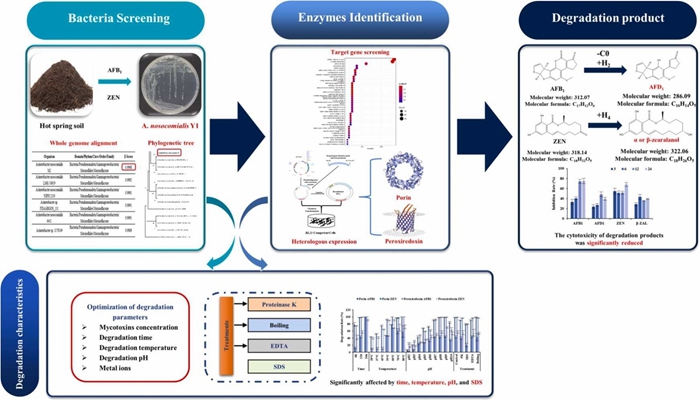Researchers from IFST-CAAS Developed Non-destructive Monitoring System for Early Detection Mold Contamination in Grapes
Throughout the storage period of grapes, they are prone to fungal contamination, resulting in notable economic losses and concerns about food safety. Current methods for identifying grape mold, including PCR, ELISA, electronic noses, and hyperspectral imaging, are marred by challenges such as costly equipment, personnel training expenses, intricate sample preparation, and insufficient sensitivity and specificity. Hence, there is a pressing need for an economical, non-destructive, and highly sensitive detection method. This method would enable the early monitoring and warning of mold occurrences in grapes during storage.
To address this issue, researchers from Institute of Food Science and Technology (IFST) of CAAS constructed a set of Escherichia coli reporter strains by fusing 14 stress-responsive promoters with the luciferase reporter gene. They combined various data preprocessing algorithms and an optimized machine learning model to successfully achieve accurate non-destructive monitoring of mold contamination in grapes by Aspergillus niger, A. westerdijkiae , and Botrytis cinerea . The research results indicate that these engineered bacterial reporters strains are highly sensitive to volatile organic compounds released by infected grapes and can clearly distinguish between grapes in the asymptomatic stage (1 day after infection) and the symptomatic stage (2 days after infection). The machine learning prediction model can classify the degree of infection by three fungi on grapes, with classification accuracy reaching 100% for black mold, 92% for red mold, and 92% for gray mold, demonstrating exceptionally high predictive performance.
This novel bio-sensing technology, based on genetically engineered bacteria, enables rapid, non-destructive, and cost-effective monitoring of fungal spoilage in grapes. It can be applied not only to grapes but also to the microbiological spoilage detection of other agricultural products, making it a promising innovation. The next step will focus on enhancing the sensor's specificity and operational lifespan, with the goal of achieving widespread application in the storage and transportation of agricultural products.
The research results have been published online in the internationally renowned academic journal "Postharvest Biology and Technology" (JCR Q1, Top 5%, IF="7.0)" in the field of postharvest technology for biological and horticultural products. Dr. Junning Ma, a postdoctoral researcher from the mycotoxin prevention and control in agro-products innovation team, is the first author of the paper, and Researcher Fuguo Xing is the corresponding author. This research was funded by National Key R&D Program of China (2022YFD0400104) and Agricultural Science and Technology Innovation Program of Institute of Food Science and Technology, Chinese Academy of Agricultural Sciences (CAAS-ASTIP-G2022-IFST-01).
Link to paper:
https://www.sciencedirect.com/science/article/pii/S0304389423013882

Figure 1 Graphical Abstract
-
 Apr 18, 2024Opening Ceremony of the Training Workshop on Wheat Head Scab Resistance Breeding and Pest Control in Africa Held in CAAS
Apr 18, 2024Opening Ceremony of the Training Workshop on Wheat Head Scab Resistance Breeding and Pest Control in Africa Held in CAAS -
 Apr 03, 2024IPPCAAS Co-organized the Training Workshop on Management and Application of Biopesticides in Nepal
Apr 03, 2024IPPCAAS Co-organized the Training Workshop on Management and Application of Biopesticides in Nepal -
 Mar 28, 2024Delegation from the School of Agriculture and Food Science of University College Dublin, Ireland Visit to IAS, CAAS
Mar 28, 2024Delegation from the School of Agriculture and Food Science of University College Dublin, Ireland Visit to IAS, CAAS -
 Mar 25, 2024Director of World Food Prize Foundation visited GSCAAS
Mar 25, 2024Director of World Food Prize Foundation visited GSCAAS -
 Mar 20, 2024Institute of Crop Sciences (ICS) and Syngenta Group Global Seeds Advance Collaborative Research in the Seed Industry
Mar 20, 2024Institute of Crop Sciences (ICS) and Syngenta Group Global Seeds Advance Collaborative Research in the Seed Industry
